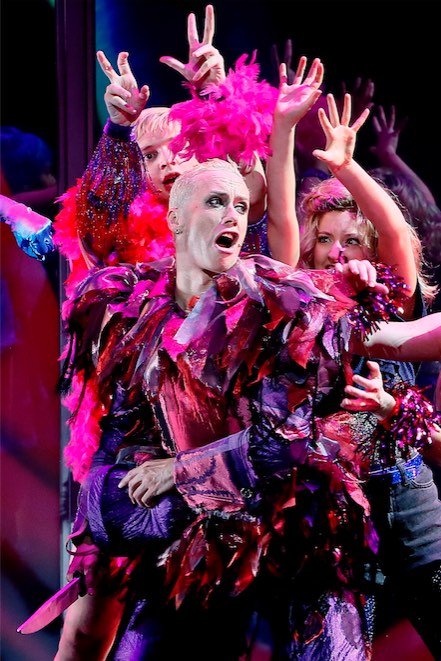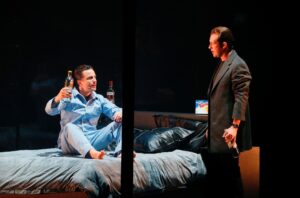News
12 Jul 2019
Bowie Does Brecht – Lighting ‘Lazarus’

Subscribe to CX E-News
THEATRE
Bowie Does Brecht
Lighting ‘Lazarus’
by Jason Allen.
Photo Credit: Jeff Busby.
One of David Bowie’s final creative projects, the musical ‘Lazarus’ came to Melbourne’s Playhouse in May for its first Australian production. Multi-award winning lighting designer Paul Jackson worked with The Production Company and director Michael Kantor to bring the enigmatic vision to life…
While ‘Lazarus’ features 18 of Bowie’s very identifiable songs, no sane person would refer to it as a jukebox musical. With a book by Irish playwright Enda Walsh, the fever-dream narrative of the show can be seen as a sequel to the novel The Man Who Fell to Earth, which famously starred Bowie in the 1976 film adaptation.
Lazarus’s main character, the (possibly) alien Thomas Newton Howard is tormented by real and imagined characters, while a live band backs the vocally talented cast through often radically re-arranged Bowie hits that are as much a part of the fabric of the show as the set.
The overall effect is disorienting. Littered with lyrical and visual allusions to Bowie’s catalogue, the Melbourne production seized on the deeply German aesthetic of the show – think expressionist theatre, abstract opera,and above all Brechtian detachment. This was definitely much more a trip to Berlin than to Broadway.
Working with this creative framework, and the compressed timeframes The Production Company is famous for, lighting designer Paul Jackson combined theatre, rock, and opera lighting around the physical centrepiece of the show; a 12-panelled, two storey tall Smart Glass array that featured almost constant video projections created by artist Natasha Pincus and engineered by Nick Roux.
Smart Glass turns from transparent to opaque in reaction to voltage, and in this case formed a gigantic canvas that explored the inner workings of the character’s minds.
“Director Michael Kantor and I have worked together for many years, mostly at the Malthouse Theatre,” explained Paul. “He’s wanted to work with a Smart Glass wall for a number of years now, and was finally given the opportunity.
“Smart Glass is a clear glass and a front and rear projection surface simultaneously. Nick had two 20K projectors rigged to rear-project onto it.”
Smart Glass is neither cheap nor common, which meant a limited amount of time and materials for Paul to refine his design. “I was only able to run tests with very small amounts of Smart Glass, which meant I only really saw the full effect of the large scale projections after we bumped in, six days before previews,” Paul continued.
“The issues that became evident when we saw the lighting around the glass were solved by upping the saturation and colour toning.”
While glass set pieces and lighting fixtures typically don’t mix, Paul has had a surprising amount of experience dealing with them together. “I’ve done a lot of shows that were encased in glass,” he related.
“Normally, you can find an angle to shoot through glass to fill out faces. In this production of Lazarus, that can’t happen at all, because the emulsion embedded in the Smart Glass makes the light go milky. Once we discovered that, we had to retrain the performers, and my main job became lighting the show while staying off the glass.
“Whilst I was keeping light off the projections, I also had to support their looks, and occasionally colour tone them.”
With the Smart Glass wall eliminating a lot of the standard options for characters and faces, Paul turned to side lighting. In Brechtian style, completely visible to the audience, the extensive booms sidestage tower as tall as the screen and are packed with ETC Source Fours and Lustrs.
“The sidelights are doing most of the work lighting faces and the action of the show,” confirmed Paul.
“We had five lighting bars flown upstage of the glass and two downstage. Three bars upstage of the glass were lighting the action, dance and toning the screen, with two more bars over the band. On LX1 just over the downstage, I’ve got seven PRG Best Boys HPs.
“On LX2 downstage of the glass are seven Claypaky Scenius Unicos, and a few 2K Fresnels. All up I’ve got 25 Unicos and 10 Best Boys, with GLP impression 4s lighting the band on the upstage rostrum.
 “The Scenius Unicos are beautiful instruments, perfectly pitched for this kind of show, while I find Best Boys are always glorious to work with.”
“The Scenius Unicos are beautiful instruments, perfectly pitched for this kind of show, while I find Best Boys are always glorious to work with.”
Most of the rig, with the exception of the Source Fours, was generously provided by PRG. With the stage bifurcated by the Smart Glass wall, the available space for the actors and dancers is limited, pushing most of the action to thin strips up and down stage.
The band is visible upstage instead of in a pit, so not only is this conceptually unlike any other musical in the repertoire, it’s also physically different.
“Bowie’s music and lyrics are not your normal kind of musical fodder, nor are they normal rock and roll,” elaborated Paul. “We had to find a theatrical vocabulary that supports the show, but doesn’t try to overwhelm it. A lot of the techniques and strategies you would use in a normal musical would just debase this material.
“Hopefully, we found that balance. What we’re looking for is somewhere between a musical, music video, and theatre. Lighting had to do the normal work of a musical whilst understanding that a large amount of that work is being done by the screen imagery.
“It’s trying to find a balance between supporting the performers in what they’re doing, but not overstimulating the stage.”
A harrowing show emotionally, Lazarus constantly reminds you of the passing of Bowie, his alien presence, and his chameleonic body of work.
“Working on jukebox musicals, you often walk away having had quite enough of their songs for quite some time,” said Paul. “I’ve been walking away from Lazarus wanting to listen to Bowie again. I keep playing Bowie driving home.
“The beauty of this piece is as a reminder of how great a musician and lyricist Bowie was. It’s been quite moving in a way I didn’t expect it to be, and has taken me deeper and deeper into his work.”
CX Magazine – July 2019 Entertainment technology news and issues for Australia and New Zealand – in print and free online www.cxnetwork.com.au
© CX Media
Subscribe
Published monthly since 1991, our famous AV industry magazine is free for download or pay for print. Subscribers also receive CX News, our free weekly email with the latest industry news and jobs.













